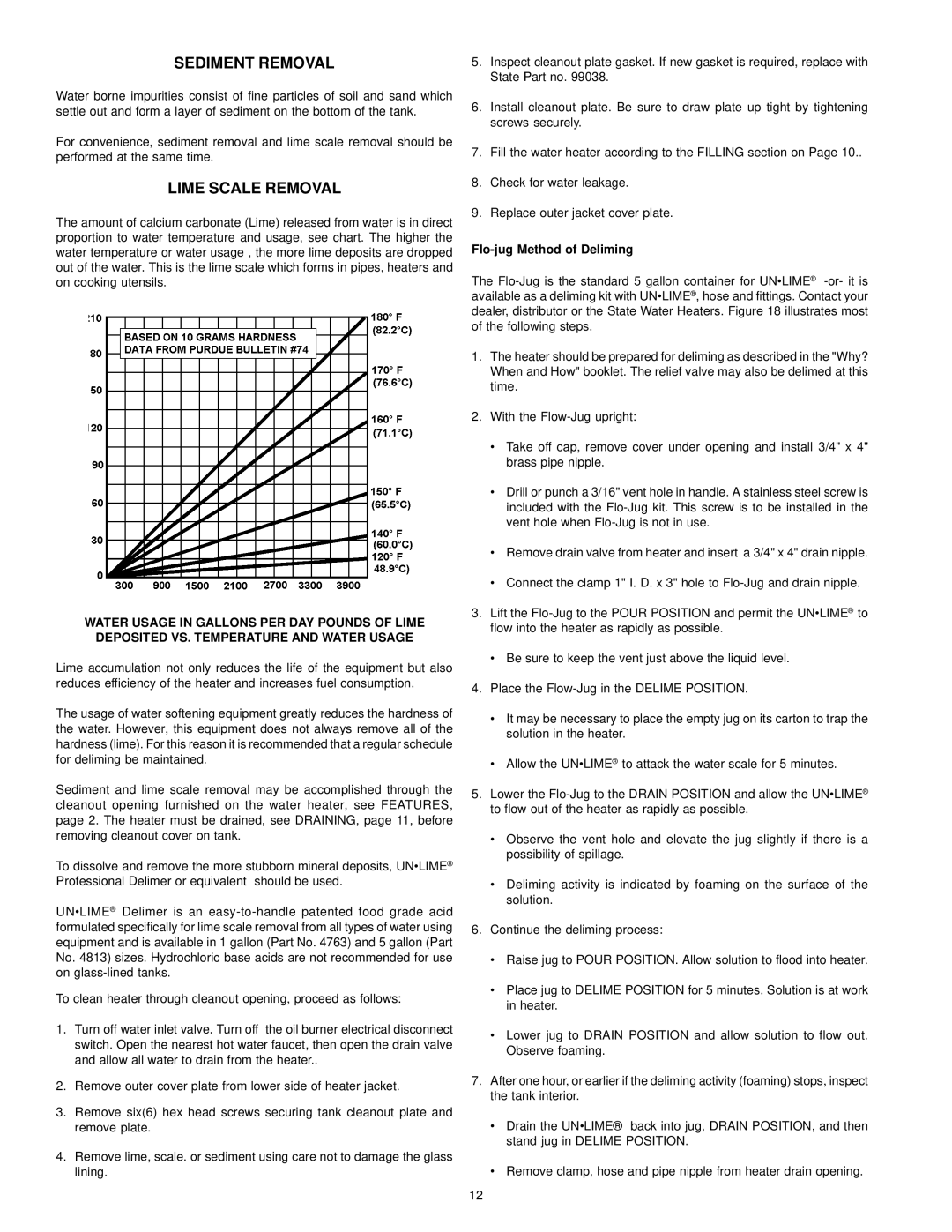
SEDIMENT REMOVAL
Water borne impurities consist of fine particles of soil and sand which settle out and form a layer of sediment on the bottom of the tank.
For convenience, sediment removal and lime scale removal should be performed at the same time.
LIME SCALE REMOVAL
The amount of calcium carbonate (Lime) released from water is in direct proportion to water temperature and usage, see chart. The higher the water temperature or water usage , the more lime deposits are dropped out of the water. This is the lime scale which forms in pipes, heaters and on cooking utensils.
WATER USAGE IN GALLONS PER DAY POUNDS OF LIME
DEPOSITED VS. TEMPERATURE AND WATER USAGE
Lime accumulation not only reduces the life of the equipment but also reduces efficiency of the heater and increases fuel consumption.
The usage of water softening equipment greatly reduces the hardness of the water. However, this equipment does not always remove all of the hardness (lime). For this reason it is recommended that a regular schedule for deliming be maintained.
Sediment and lime scale removal may be accomplished through the cleanout opening furnished on the water heater, see FEATURES, page 2. The heater must be drained, see DRAINING, page 11, before removing cleanout cover on tank.
To dissolve and remove the more stubborn mineral deposits, UN•LIME® Professional Delimer or equivalent should be used.
UN•LIME ® Delimer is an
To clean heater through cleanout opening, proceed as follows:
1.Turn off water inlet valve. Turn off the oil burner electrical disconnect switch. Open the nearest hot water faucet, then open the drain valve and allow all water to drain from the heater..
2.Remove outer cover plate from lower side of heater jacket.
3.Remove six(6) hex head screws securing tank cleanout plate and remove plate.
4.Remove lime, scale. or sediment using care not to damage the glass lining.
5.Inspect cleanout plate gasket. If new gasket is required, replace with State Part no. 99038.
6.Install cleanout plate. Be sure to draw plate up tight by tightening screws securely.
7.Fill the water heater according to the FILLING section on Page 10..
8.Check for water leakage.
9.Replace outer jacket cover plate.
Flo-jug Method of Deliming
The
1.The heater should be prepared for deliming as described in the "Why? When and How" booklet. The relief valve may also be delimed at this time.
2.With the
•Take off cap, remove cover under opening and install 3/4" x 4" brass pipe nipple.
•Drill or punch a 3/16" vent hole in handle. A stainless steel screw is included with the
•Remove drain valve from heater and insert a 3/4" x 4" drain nipple.
•Connect the clamp 1" I. D. x 3" hole to
3.Lift the
•Be sure to keep the vent just above the liquid level.
4.Place the
•It may be necessary to place the empty jug on its carton to trap the solution in the heater.
•Allow the UN•LIME ® to attack the water scale for 5 minutes.
5.Lower the
•Observe the vent hole and elevate the jug slightly if there is a possibility of spillage.
•Deliming activity is indicated by foaming on the surface of the solution.
6.Continue the deliming process:
•Raise jug to POUR POSITION. Allow solution to flood into heater.
•Place jug to DELIME POSITION for 5 minutes. Solution is at work in heater.
•Lower jug to DRAIN POSITION and allow solution to flow out. Observe foaming.
7.After one hour, or earlier if the deliming activity (foaming) stops, inspect the tank interior.
•Drain the UN•LIME® back into jug, DRAIN POSITION, and then stand jug in DELIME POSITION.
•Remove clamp, hose and pipe nipple from heater drain opening.
12
